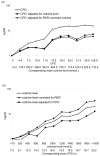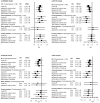Genetic polymorphisms in 15q25 and 19q13 loci, cotinine levels, and risk of lung cancer in EPIC
- PMID: 21862624
- PMCID: PMC5697736
- DOI: 10.1158/1055-9965.EPI-11-0496
Genetic polymorphisms in 15q25 and 19q13 loci, cotinine levels, and risk of lung cancer in EPIC
Abstract
Backgrounds: Multiple polymorphisms affecting smoking behavior have been identified through genome-wide association studies. Circulating levels of the nicotine metabolite cotinine is a marker of recent smoking exposure. Hence, genetic variants influencing smoking behavior are expected to be associated with cotinine levels.
Methods: We conducted an analysis in a lung cancer case-control study nested within the European Prospective Investigation into Cancer and Nutrition (EPIC) cohort. We investigated the effects of single-nucleotide polymorphisms (SNP) previously associated with smoking behavior on (i) circulating cotinine and (ii) lung cancer risk. A total of 894 cases and 1,805 controls were analyzed for cotinine and genotyped for 10 polymorphisms on 7p14, 8p11, 10q23, 15q25, and 19q13.
Results: Two variants in the nicotinic acetylcholine receptor subunit genes CHRNA5 and CHRNA3 on 15q25, rs16969968 and rs578776, were associated with cotinine (P = 0.001 and 0.03, respectively) in current smokers and with lung cancer risk (P < 0.001 and P = 0.001, respectively). Two 19q13 variants, rs7937 and rs4105144, were associated with increased cotinine (P = 0.003 and P < 0.001, respectively) but decreased lung cancer risk (P = 0.01 for both, after adjusting for cotinine). Variants in 7p14, 8p11, and 10q23 were not associated with cotinine or lung cancer risk.
Conclusions: 15q25 and 19q13 SNPs were associated with circulating cotinine. The directions of association for 15q25 variants with cotinine were in accordance with that expected of lung cancer risk, whereas SNPs on 19q13 displayed contrasting associations of cotinine and lung cancer that require further investigation.
Impact: This study is the largest to date investigating the effects of polymorphisms affecting smoking behavior on lung cancer risk using circulating cotinine measures as proxies for recent smoking behavior.
©2011 AACR
Figures


Similar articles
-
Contribution of Variants in CHRNA5/A3/B4 Gene Cluster on Chromosome 15 to Tobacco Smoking: From Genetic Association to Mechanism.Mol Neurobiol. 2016 Jan;53(1):472-484. doi: 10.1007/s12035-014-8997-x. Epub 2014 Dec 5. Mol Neurobiol. 2016. PMID: 25471942 Review.
-
Fine-mapping of the 5p15.33, 6p22.1-p21.31, and 15q25.1 regions identifies functional and histology-specific lung cancer susceptibility loci in African-Americans.Cancer Epidemiol Biomarkers Prev. 2013 Feb;22(2):251-60. doi: 10.1158/1055-9965.EPI-12-1007-T. Epub 2012 Dec 5. Cancer Epidemiol Biomarkers Prev. 2013. PMID: 23221128 Free PMC article.
-
Role of 5p15.33 (TERT-CLPTM1L), 6p21.33 and 15q25.1 (CHRNA5-CHRNA3) variation and lung cancer risk in never-smokers.Carcinogenesis. 2010 Feb;31(2):234-8. doi: 10.1093/carcin/bgp287. Epub 2009 Dec 2. Carcinogenesis. 2010. PMID: 19955392
-
Multiple independent loci at chromosome 15q25.1 affect smoking quantity: a meta-analysis and comparison with lung cancer and COPD.PLoS Genet. 2010 Aug 5;6(8):e1001053. doi: 10.1371/journal.pgen.1001053. PLoS Genet. 2010. PMID: 20700436 Free PMC article.
-
CHRNA5 risk variant predicts delayed smoking cessation and earlier lung cancer diagnosis--a meta-analysis.J Natl Cancer Inst. 2015 Apr 14;107(5):djv100. doi: 10.1093/jnci/djv100. Print 2015 May. J Natl Cancer Inst. 2015. PMID: 25873736 Free PMC article. Review.
Cited by
-
Tobacco smoke biomarkers and cancer risk among male smokers in the Shanghai cohort study.Cancer Lett. 2013 Jun 28;334(1):34-8. doi: 10.1016/j.canlet.2012.07.016. Epub 2012 Jul 20. Cancer Lett. 2013. PMID: 22824243 Free PMC article.
-
Contribution of Variants in CHRNA5/A3/B4 Gene Cluster on Chromosome 15 to Tobacco Smoking: From Genetic Association to Mechanism.Mol Neurobiol. 2016 Jan;53(1):472-484. doi: 10.1007/s12035-014-8997-x. Epub 2014 Dec 5. Mol Neurobiol. 2016. PMID: 25471942 Review.
-
Familial Lung Cancer: A Brief History from the Earliest Work to the Most Recent Studies.Genes (Basel). 2017 Jan 17;8(1):36. doi: 10.3390/genes8010036. Genes (Basel). 2017. PMID: 28106732 Free PMC article. Review.
-
Genetic association analysis of complex diseases incorporating intermediate phenotype information.PLoS One. 2012;7(10):e46612. doi: 10.1371/journal.pone.0046612. Epub 2012 Oct 19. PLoS One. 2012. PMID: 23094028 Free PMC article.
-
A common genetic variant at 15q25 modifies the associations of maternal smoking during pregnancy with fetal growth: the generation R study.PLoS One. 2012;7(4):e34584. doi: 10.1371/journal.pone.0034584. Epub 2012 Apr 4. PLoS One. 2012. PMID: 22496830 Free PMC article.
References
-
- Pathology and Genetics of Tumors of the Lung, Pleura and Heart. IARCPress; Lyon: 2004. World Health Organization Classification of Tumors.
-
- Parkin DM, Pisani P, Lopez AD, Masuyer E. At least one in seven cases of cancer is caused by smoking. Global estimates for 1985. Int J Cancer. 1994;59:494–504. - PubMed
-
- Gorber SC, Schofield-Hurwitz S, Hardt J, Levasseur G, Tremblay M. The accuracy of self-reported smoking: a systematic review of the relationship between self-reported and cotinine-assessed smoking status. Nicotine Tob Res. 2009;11:12–24. - PubMed
Publication types
MeSH terms
Substances
Grants and funding
LinkOut - more resources
Full Text Sources
Medical

